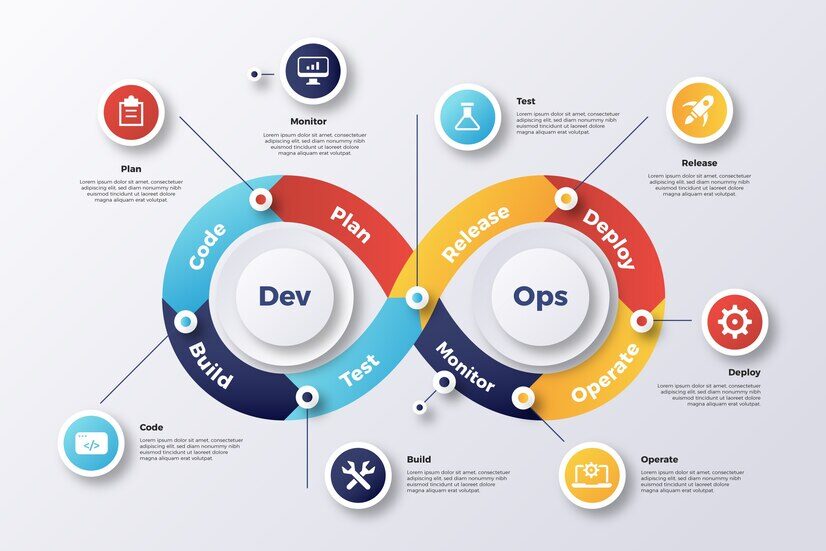Speeding SugarCRM Launch with DevOps at Ambit Software
Share Blog

In the fast-paced digital world today, companies have to innovate continuously if they are to remain competitive. Providing software rapidly, reliably, and efficiently is no longer a choice; it’s a requirement. At Ambit Software, we understand the necessity for an efficient method that guarantees quick deployment, quality software, and effective collaboration among teams. Our DevOps Development Methodology is meant to close the gap between operations and development, building a cohesive, streamlined process from coding and planning right through to testing, deployment, and ongoing feedback.
Our DevOps approach is based on automation, collaboration, and real-time monitoring to ensure that all software releases are faster, more reliable, and aligned with changing business needs. By adopting continuous integration (CI), continuous delivery (CD), and real-time feedback loops, we ensure that the software products are always high-quality, scalable, and customer centric.
With a nimble strategy and state-of-the-art tools, Ambit Software equips organizations with strong DevOps solutions that boost productivity, reduce downtime, and automate IT processes. Our approach enables organizations to respond to evolving market needs while upholding the highest levels of security, performance, and innovation.

Why DevOps Development Methodology?
DevOps is not simply a fad; it’s a revolutionary philosophy that speeds up software development and intensifies collaboration between teams. It eradicates barriers between development and operations, thereby helping organizations optimize software quality, lower deployment breaks, and send updates at higher speeds than previously.
The DevOps market is expected to expand from $10.4 billion in 2023 to $25.5 billion by 2028, highlighting its importance in contemporary software development. The main drivers of this expansion are automation, continuous testing, and AI-based monitoring, all of which assist companies in streamlining workflows and enhancing software reliability.
Some of the most important advantages of DevOps are:
Accelerated time-to-market: Continuous integration and deployment allow for faster rollouts of new features and updates.
Increased efficiency: Automation eliminates human errors and accelerates the development cycle.
Enhanced software quality: Automated testing and real-time monitoring guarantee high performance and security standards.
Enhanced collaboration: DevOps foster a sense of shared responsibility, resulting in efficient collaboration.
As per Harvard Business Review, 86% of organizations identify DevOps as an essential part of their success.
DevOps phases
DevOps has a systematic continuous cycle that incorporates different processes to provide software reliability and efficiency. This is how each step leads to a seamless software development and deployment process:
1. Continuous Planning
- The DevOps cycle starts with Continuous Planning, in which teams set goals, prioritize tasks, and create timelines.
- Sprint Planning Tool: Schedules development tasks into manageable sprints to ensure alignment with business objectives.
- Integrated Development Environments (IDEs): Offer coding, debugging, and testing capabilities, increasing developer productivity.
2. Continuous Development
- Development is a continuous process, enabling incremental changes without interrupting workflows.
- Source Code Management: GitHub and GitLab enable collaborative coding, branching, and version control.
- Automated Code Checks: Ongoing scanning for defects ensures high-quality code prior to deployment.
3. Build
- After code is committed, the Build phase starts, compiling the software and getting it ready for testing.
- Continuous Integration (CI) Servers: Jenkins and GitLab CI integrate code automatically and detect issues early.
4. Unit Testing & Static Analysis
- Testing is incorporated in every phase, beginning with unit testing and static code analysis.
- Unit Testing: Tests individual code components to ensure they work as expected.
- Static Analysis: Identifies vulnerabilities, bugs, and inefficiencies through tools such as SonarQube.
5. Reporting
- Automated reports include information about software quality, security vulnerabilities, and coverage, aiding teams in addressing issues pre-emptively.
6. Continuous Testing
- Continuous testing keeps the software reliable across various environments.
- Repository Management: Retains all software versions easily accessible for comparison. Defect Management: Tracks, prioritizes, and fixes identified problems.
7. Execute Deployment
- Once tested, the software is deployed smoothly using automated tools.
- Continuous Deployment (CD): Provides smooth rollouts with minimal human intervention.
- Staging Environments: QA and staging environments validate the software works correctly prior to production release.
8. Continuous Delivery & Monitoring
- After deployment, ongoing monitoring validates system performance and uptime.
- Production Monitoring: New Relic and Datadog offer real-time visibility.
- Defect Management: Issue resolution is rapid, reducing disruption.
9. Continuous Feedback
- User and business feedback drive continuous improvement for upcoming software releases, promoting customer satisfaction and business alignment.

Advantages of DevOps Methodology
- Faster Software Releases
With ongoing innovation and automation, companies are able to deploy new features quickly while maintaining reliability and performance.
Better Team Collaboration
Through bridging the gap between development and operations, DevOps facilitates more effective communication, quicker problem-solving, and better decision-making between teams.
Better Software Quality
With test automation and live monitoring, potential problems are detected and fixed early on, providing smooth user experiences.
Increased Customer Satisfaction
DevOps enables companies to respond rapidly to customer feedback, making significant changes that increase user interaction and experience.
Increased Efficiency through Automation
Automation eliminates the tedium of repeat tasks, enabling teams to channel their efforts into innovation while keeping errors and inefficiencies at bay.
Adherence to Continuous Improvement
Through the utilization of continuous feedback and optimization, DevOps helps companies improve and mature their processes with every cycle of development.
DevOps Objectives
Accelerate Delivery: Automated processes mean faster software releases.
Enhance Collaboration: Promoting collective ownership improves teamwork and productivity.
Give Quick Feedback: Automated testing and reporting accelerate the resolution of problems.
Establish an Extensible Infrastructure: Stable systems provide flexibility for business expansion.
Provide Value to Customers: Regular updates and improvements make businesses competitive.
Common Misconceptions regarding Agile and DevOps
Although Agile and DevOps are often used interchangeably, the two are quite different with regards to intent and purpose. Agile is an iterative approach to software development that typically sees teams delivering enhancements to a product in short cycles for more flexibility and responsiveness. DevOps carries Agile principles beyond development into all the stages of the software lifecycle-from planning through development, deployment, and even during maintenance.
DevOps hopes to build upon Agile by encouraging collaborative operations between development and operations teams. Agile, on the other hand, improves the speed and adaptability of software development by enabling the code to be integrated and tested smoothly with the least incidence of deployment errors.
Another misunderstanding is that DevOps is fully automated, and while automation is one of the critical drivers of DevOps, it is also about communication, culture change, and optimizing processes. No automation can replace a culture of collaborative work; this is how DevOps should gain the most.
Some also think DevOps will eliminate the need for IT operations teams. In fact, DevOps will redefine the role of such teams from reactive maintenance to proactive considerations of performance tuning, security, and infrastructure automation.
Conclusion
DevOps is a game-changer for software development, enabling faster, more reliable, and higher-quality releases. At Ambit Software, we integrate DevOps principles into every stage of development—utilizing automation, continuous feedback, and real-time monitoring to enable businesses to succeed in today’s fast-paced digital economy.
Set to speed up your software release? Let us talk about how Ambit Software can make your business a DevOps success story!
